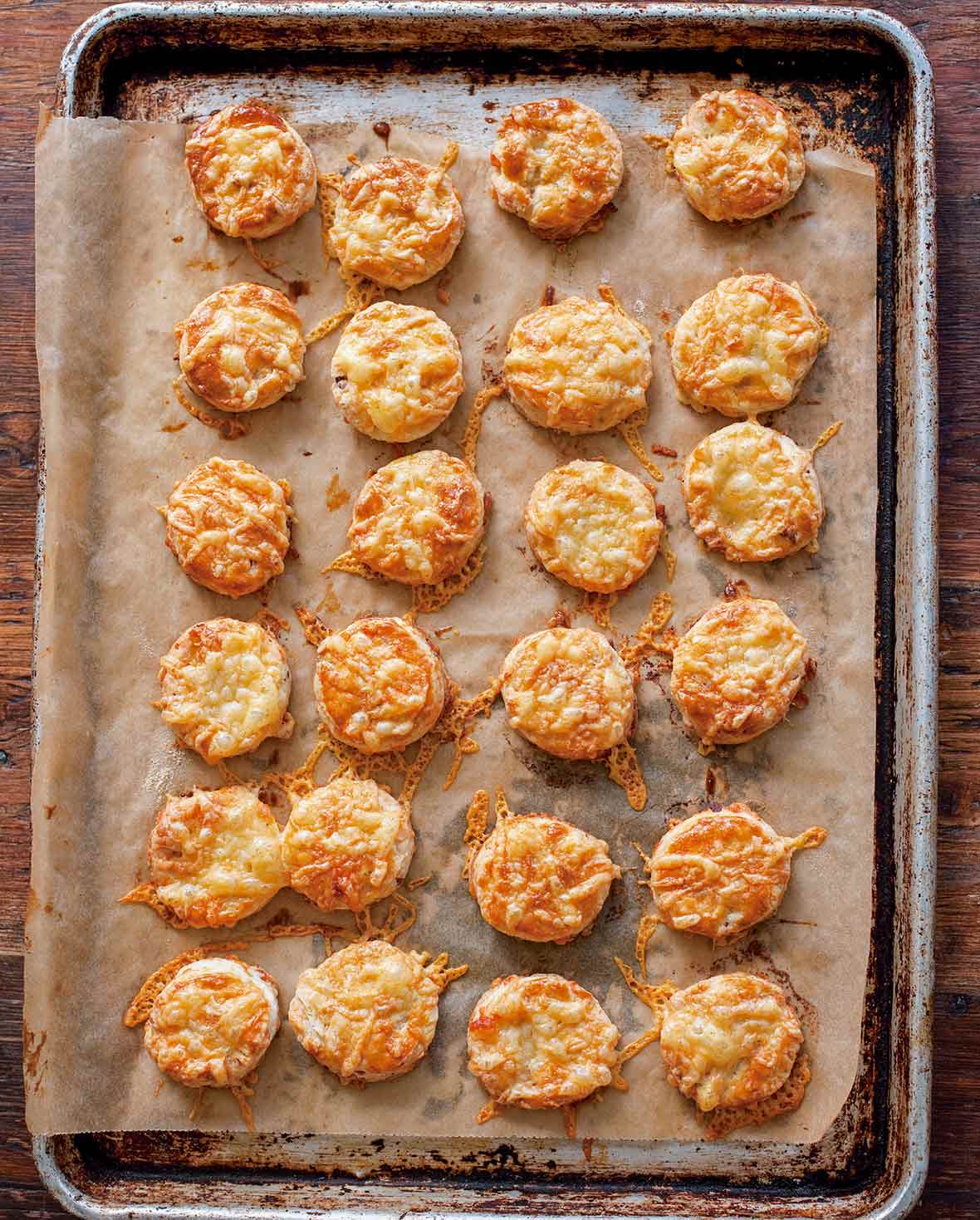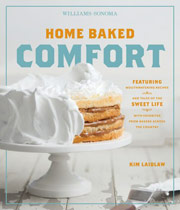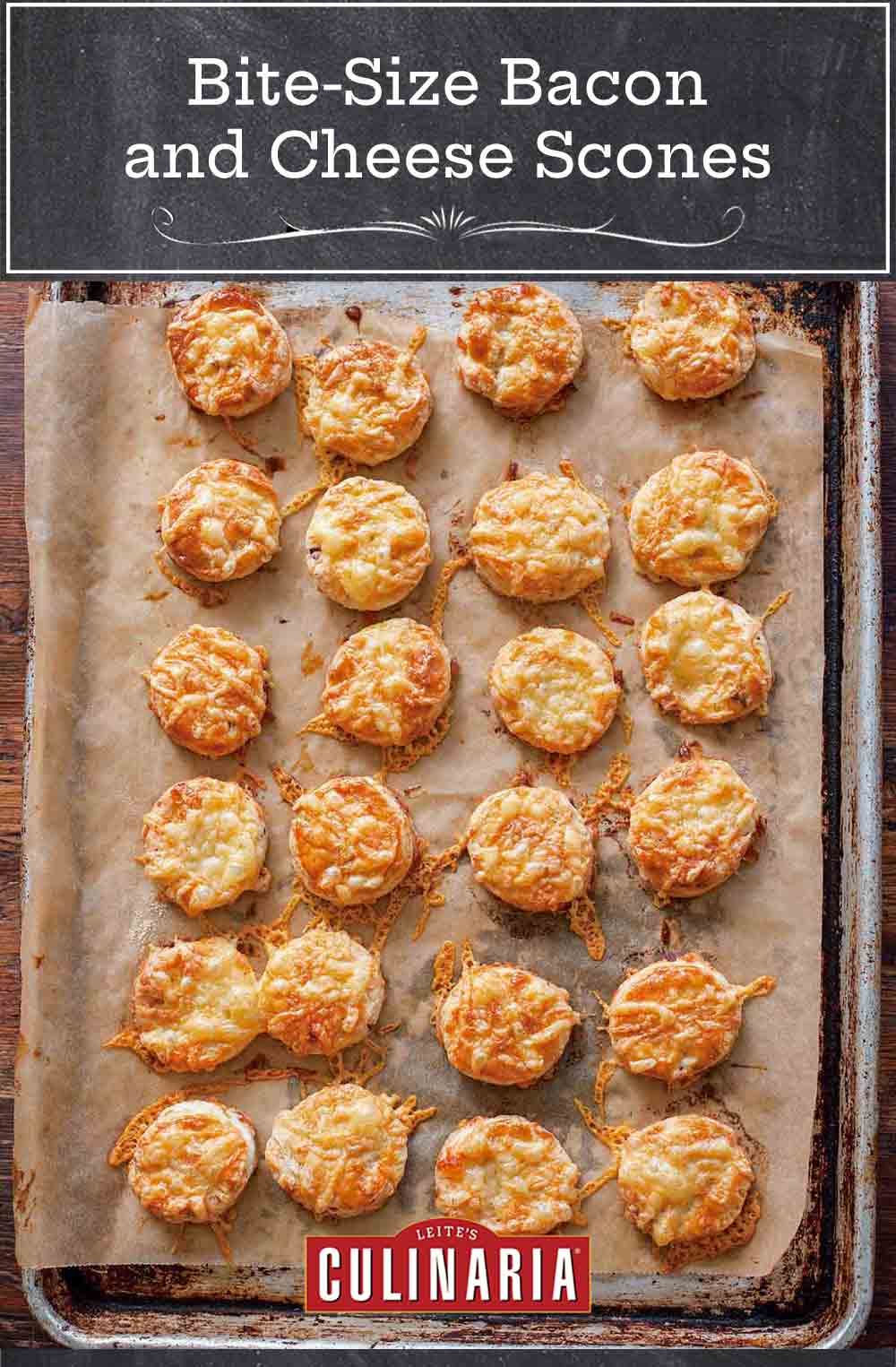
We had a tricky time discerning what to call these cute-as-a-button, buttery little bundles of bacony, cheesy goodness. Call something a scone and you summon notions of a particular sort of flakey, buttery baked good. Call something a biscuit and that brings about more savory connotations. These meld the best attributes of both. Not that you can go wrong either way with these little lovelies, whether served morning, noon, night, or any time in between.–Renee Schettler Rossi

Bacon and Cheese Scones
Ingredients
- 3 slices thick-cut applewood-smoked bacon
- 2 cups all-purpose flour, plus more for the work surface
- 2 teaspoons baking powder
- 1 cup finely grated Asiago or Gruyere cheese, plus more for sprinkling if you please
- Pinch of kosher salt, (if you add 1/4 teaspoon, you’ll be just fine)
- 1/2 teaspoon freshly ground black pepper
- 1 (4-ounce) stick unsalted butter, cold, cut into chunks
- 1 large egg
- 3/4 cup heavy cream or whole milk
Instructions
- Preheat the oven to 400°F (204°C) and position a rack in the middle of the oven. Line a rimmed baking sheet with parchment paper.
- In a skillet, fry the bacon over medium-low heat until lightly crisp, about 5 minutes. Transfer the bacon to a cutting board and finely chop it.
- In a food processor, dump the flour, baking powder, cheese, salt, and pepper and pulse briefly to mix. Add the butter and pulse until the mixture looks like coarse meal.
- In a small bowl, whisk together the egg and cream or milk until blended. Pour the egg mixture into the processor and pulse just until the dough begins to pull away from the sides of the bowl and come together into a ball. The dough will be quite sticky.
- Turn the dough onto a lightly floured work surface. Gently knead in the bacon by sprinkling the surface of the dough with some of the chopped bacon, folding the dough onto itself, and then repeating the sprinkling and folding until all of the bacon is incorporated. Be careful not to overhandle the dough.
- Then bring the dough together into a ball. Using a lightly floured rolling pin, roll out the dough to 1/2 inch thickness. Using a 1 1/2-inch biscuit cutter, cut out as many scones as you can. Gather the scraps of dough, roll out, and cut out more scones.
- Space the scones evenly on the prepared baking sheet. Sprinkle the tops of the scones with additional cheese, if desired. [Editor’s Note: We strongly encourage you to abide by this suggestion.]
- Bake until the scones are golden, 12 to 15 minutes. Transfer to a wire rack and let cool slightly before serving, if you can stand to wait.

Nutrition
Nutrition information is automatically calculated, so should only be used as an approximation.
Recipe Testers’ Reviews
In one word: dangerous. These mini scones are so good they’re dangerous. I used Gruyère in mine and the flavor paired so well with the smoky bacon it was heavenly. These are easy to make, present beautifully, and are a perfect size for a brunch or snack. They bake up flaky, tall and light. These scones are so easy to pop in your mouth.
The bigger the group you make them for, the better, because there will not be any leftovers, regardless of how many people at your party.
“Addictive” is the word I would use for these delectable little morsels. I’m not a baker, but even I could make this recipe and have them turn out perfect. But I would call them biscuits instead of scones. The recipe worked exactly as written.
I chose to use Asiago cheese this time around, but will try them again using Gruyère. I felt the mild taste of the Asiago is almost lost amongst the bacon, but you did get that saltiness, almost as if you using Parmesan. On half the scones, I used extra cheese on top. I left the other half plain. I wasn’t sure how the cheese would bake up, so I just used a little bit. Next time I will be more generous with the cheese on top.
I ended up with five dozen scones, and they all fit on one pan. I wasn’t sure how they would taste with a salad, as suggested in the recipe, but it was surprisingly good. I can also see these being served with a loaded baked potato soup or corn chowder.
This recipe should come with a warning sign–it’s very easy to pop a few of these delicious little bites into your mouth without even thinking about it–and the aroma in the kitchen will kill you! The instructions are excellent, from the ingredient amounts to the mixing everything works beautifully. Times and yield are very accurate as well. I have had bacon and cheese scones before, but something about these being really small makes them taste better than I thought they would.
The suggestion to add a pinch of grated cheese on top is a great one, it adds a lot of eye appeal, but the cheese had to be pretty finely grated because the tops are so small. I found the best way was to brush with a little cream and dip the top into some grated cheese.
Good scones, as I’ve learned after many years of experiencing only bad scones, have a good amount of butter in them and aren’t so dry that every bite must be followed by a sip or two of coffee. These bacon and Gruyère bite-sized goodies fall into the good scone group, and they can be enjoyed at various times of the day (great with eggs in the morn, excellent as a side to a lunch salad, etc.).
I expected the dough to be less sticky, but it all worked out with a liberal sprinkling of flour on the dough and extra on the board and rolling pin. My taster and I agreed that the ones with the extra cheese on top were the best (used about 1/8 cup more cheese) and that cutting the bacon into smaller pieces (more like bacon bits) would have distributed the bacon flavor better. These scones are great served warm, and even a day later, they still were delicious and not dry or crumbly. I will definitely make this recipe again and likely will try to add some shortcuts that take advantage of the food processor while I have it out (e.g., grating the cheese in the food processor as opposed to using a separate grater).
These Bite-Size Bacon and Cheese Scones were heaven in two bites! They were perfectly flaky and tender little scones. We liked the smaller size and it was hard to stop eating them.
The recipe was fast, delicious, and had only one suggestion from my testers: “More bacon, please!”
I think I’ll add a couple more slices of bacon next time–and there will definitely be a next time.
These turned out just as promised by the author: buttery, bacony, and cheesy. I used heavy cream and Asiago for my cheese choice. If you make these, go ahead and do as the author suggests and take them over the top by adding a pinch of grated cheese to the tops before baking.
I did that on a little over half of mine, and they were everyone’s favorite–including mine. These would make great appetizers for a party, or do like hubby and I did and eat them for breakfast with your scrambled eggs. I would only do one thing differently next time. I would roll out my dough, then sprinkle the bacon and press it in before cutting to more evenly distribute my bacon. After kneading in the bacon and then rolling out and cutting the scones, I had a few that didn’t have bacon in them.
Mmmm. Bacon and cheese in scones. What could be better? These little scones come together very quickly.
I had to use an aged Gouda cheese (I was out of Gruyère) and loved that most of the work is done in the food processor. As my son was in the middle of packing his groceries for school on the counter, my space was limited. I was able to pat smallish circles of the lovely dough and cut the scones before baking. They did take a little longer to bake, closer to 15 minutes. They were fabulous! They were tender and perfect with the braised beef for dinner.
This is definitely a keeper recipe and I can’t wait to make these again with a different combination of cheese and bacon, or pancetta, or chorizo…the combinations seem endless.
These are really a great nibble. The recipe is easy enough to throw together. The finished product was very flaky. The size makes you think that you can eat just one more, and then just one more. The trouble is trying to stop eating just one more.
The other problem we had was that after 12 minutes of baking, the very center of the scone was a tad raw. We needed to make the scones a little bit shorter so that the center got done. We did not want to bake the entire batch of scones, so after forming all of them, we froze about half. (We placed the unbaked scones on a sheet pan, and placed it in the freezer. After the scones were frozen, we put them into a bag, and vacuum sealed it.)
Wonderful truly describes this recipe. Scones, in general, are at the top of my “foods I love” list, and this recipe is one of the best.
I used Gruyère cheese and I highly recommend this cheese as opposed to the Asiago. The combination with the applewood-smoked bacon is to die for! I can’t stress enough to be careful not to work the dough too much. Scones can become tough if you do. Also, these are best served warm.
These really *are* hard to stop eating. The smokiness of the bacon comes through loud and clear in the finished scones. I felt almost like I was eating a bite of a ham and cheese sandwich on a biscuit.
In addition to the other suggested uses, these are nice along with a bowl of soup. I didn’t use my biggest baking sheet for these and had to make them in two batches. (I’m not sure they all would have fit at once even on my largest pan.)
I’m a sucker for scones and am always anxious to try a new recipe. As always, I prepped my mise en place the night before, gathering the dry ingredients in a bowl on the counter, and cubing the butter and leaving it to chill in the fridge overnight. This little bit of advance work makes scone deliciousness all the easier to enjoy as a weekend morning treat. These ARE dangerously good. I guarantee you won’t be able to eat just one. In fact, I didn’t stop until I had eaten six! Such a bad boy.
Anyone who’s made scones before knows that the key to their tender perfection is their high fat content (I used cream and not whole milk in making these), and not working the dough too much. For this reason, I dumped the dough from my food processor just as it started to pull away from the sides and come together in the bowl, well before it formed a ball. I dumped the shaggy, wet mass onto my floured countertop, sprinkled the chopped bacon over the top, brought it together in a ball, then folded and kneaded it just twice to evenly distribute the bacon throughout. As I had some grated Parmesan left over from pizzas the night before, I sprinkled a little on top of each bite before baking, and I highly recommend that you do the same with either a Parmesan or some of the Gruyère from the recipe. The melted cheese on top adds a welcome finish to these already delicious little treats.
I baked them off in two batches, both at 12 minutes as specified in the recipe, and found that the second batch was just slightly overcooked, likely the result of the dough being a bit warmer from re-working the scraps after the first batch was cut. The next time I make these (yes, there will definitely be a next time), I’ll cook the second batch for a minute or two less. They rose beautifully (actually, more like a biscuit than a scone), and were the perfect little nosh when they emerged with a perfume of melted cheese and smoky bacon. These scones were very tender, and when warm, practically melted in my mouth.
I thought the bacon added the perfect amount of smoky-salty chew, but would have preferred more of a kick from the cheese. I say this as a matter of personal preference, not as a criticism of the recipe. If you like the more nuanced flavor of Gruyère, then by all means use it, but I think I’ll try a sharp Cheddar the next time around for a more pronounced cheese experience.
These scones are delicious warm or at room temperature. They promise to be a big hit whenever you serve them. Truly, it’s easy to lose track of how many you’ve eaten! Each morsel is sturdy as a whole, but has a tender texture when you bite into it—a model scone. I probably don’t need to go into how brilliant the bacon and cheese combination is, as the duo is a known success.
I don’t have a biscuit cutter in the specified size, so I cut the rolled-out dough with a knife into 1-1/2 inch squares (picture small-ish saltine crackers). I highly recommend topping each scone with a bit of grated cheese before baking for an enhanced flavor and to give them a “cheesy” appearance.
The flavor of these scones is fantastic and they’re really easy to make.
Note that if you use thick sliced bacon, then you may need a longer cooking time at medium-low. You could just raise the heat and just make sure you watch the bacon as it cooks. I would chop the bacon into very small pieces, otherwise you won’t end up with enough in each little bite. This can definitely be made larger. (I did half the batter as bite-size scones and then decided to just bake the rest as large scones.)
This scones recipe was easy to prepare. When eaten warm, the bacon flavor in the scones is really very subtle, but is more pronounced when the scones are left to cool down completely.
The quantities of ingredients made for a fairly sticky dough, which I brought together with more flour. I used whole milk rather than cream. Care needs to be taken that the scones do not burn if cooked too high in the even, so I would recommend a lower shelf and 12 minutes cooking time.
The scones were flavorful and light. I would offer them with toppings such as olive tapenade, artichoke tapenade, and white chocolate ganache frosting.
A simple, clear recipe for tender little scones.
The only suggestion from my tasters, who quickly gobbled them up, was that they weren’t cheesy enough.






















Hi there, these sound heavenly! I will definitely have to try out this recipe. As a matter of fact, I was thinking about having these for my daughter’s First Communion reception at our house… do you think I could make the dough the night before? The communion is in the morning and it would just be too much to worry about along with every else I have to do that morning to get everyone ready.
Thanks,
CM
Hi Carla,
I might be inclined to have them all made, on a sheet pan in the refrigerator, ready to pop in the oven. Please let us know how your reception goes..
Beth
Headed for the kitchen…. Anyone care to explain the difference between scones, bisquits and gougeres? Also, thinking crabmeat….
Crabmeat, Casner?
Yeah, crabmeat. You know…the meat that can be removed from crabs. Dungeneses(SP?) Roll it into the dough instead of or along with the bacon.
W/ hollandiase sauce for dipping might be pretty tasty….
Hey Rick, now you’re talking!
Interesting, Casner!
crap hummm thinking
Definitely for this weekend! Simply stupendous! Worth making several batches with different kinds of cheese – I’m thinking bleu…
Jamie, do let us know how they turn out with bleu, sounds wonderful. Enjoy!
cannot wait to make these. omg, you can eat them with your eyes!
Exactly, Linda. Exactly. Love to hear what you think of them after you actually eat them the usual way…
If only we could and by pass the calorie intake!